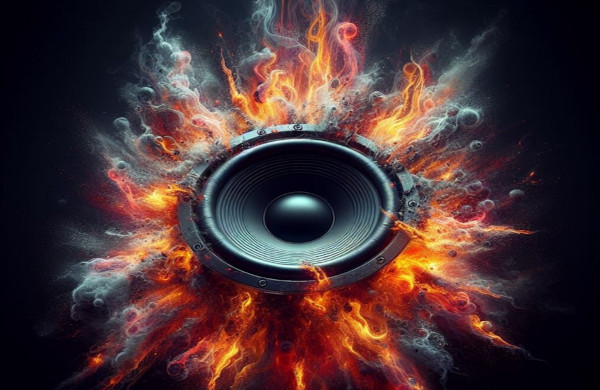WHAT ARE Realistic volume levels?
What is the optimum sound level for home playback? What does an audio reviewer mean by saying “I listened to the music at real levels”? Why is reaching the “real levels”at home impossible? And can you tell what are the actual loudness levels for a chamber quartet, rock group or a car that is driving on a highway?

The decibel (dB) is the unit used to measure how loud a sound is. Theoretically, on the decibel scale, the softest audible sound - that is total silence - is 0dB. Practically, the 0dB level is impossible to reach anywhere but in a very specialized environment.
The sound of silence
Where have you recently experienced the conditions you would call silence? Being alone at home at night? Sitting by the lake in the woods? Reading a book in a deserted library? You would be surprised that if you measured the sound level in such environment the sound meter would read something like 40dB. The real world is not silent at all even if it appears so. The closest we can get to complete silence is the inside of a heavily soundproofed anechoic chamber. Such chambers can be found at universities and sound research institutes. I was lucky to get into such the chamber at a local technical university campus.
It is a strange. The silence is realized immediately and has a profound effect on your hearing, though not the way you would expect. Instead of feeling relaxed and “free of any background noise” you feel totally disconnected from outside world, it is like diving 20 meters into the depth of an ocean. Everything sounds eerie and alienated.
The room looks unusual too: sound-dispersing and sound-cancelling spikes covering the ceiling, sound-dispersing and sound-cancelling traps covering the walls. Not the usual fashionable trapping one ca use at a home listening room but 1m thick jagged and heavy padding totally decoupled from the rooms framework. Try to speak and your words would die in fraction of second. Try to hold your breath and you would experience a discomforting pressure on your eardrums.
The problem is that even in a heavily isolated and damped room that is suspended on springs to suppress resonations coming from the outside world there is no total silence as soon as someone is inside. People move, people breathe, the hearts are pumping blood – those are soft and hardly audible sounds yet they reverberate in the anechoic room and create its “noisy” ambience that you can hear despite that a sound-level meter stays still – human hearing extends beyond sensitivity of a laboratory device.
4'33" of nearly nothing
On August 29, 1952,in New York, as part of a contemporary piano music recital, there was the premiere of the three-movement piece composed by John Cage called 4′33″. The audience saw the pianist sit at the piano and, to mark the beginning of the piece, close the keyboard lid. Later he opened it briefly, to mark the end of the first movement. This process was repeated for the second and third movements of the piece. Cage’s “composition” remains controversial to this day, and is seen as challenging the very definition of music.
With 4′33″, the music is made up of incidental sounds – those ambient sounds of the audience and a concert hall itself, there is no real sound of instruments or notes played. On top of that, the 4′33″ questions the social rules of the modern concert life etiquette, experimenting on unsuspecting concert-goers to prove an important point. The choice of a prestigious venue and the social status of the composer and the performers automatically heighten audience's expectations for the piece. As a result, the listener becomes more focused, giving Cage's 4′33″ the same amount of attention as Tschaikovsky´s opus – maybe even more attention because nothing is coming with passing time and the expectations arise. Although there is no music the sound of a rustling concert hall reaches 50dB or more, which is about the same like background noise of a quiet classroom filled with students. The difference in the loudness perception – the classroom is subjectively louder than the concert hall– lies in the size of venue and its reverberation properties.
Any performance, no matter if at home, a concert hall or stadium, is filled with sounds, silence or noise and all these elements together are absolutely necessary for completeness. The difference in how loud we perceive the music is relative and can be best expressed through the famous S/N ratio – the signal (music) has to be loud enough over the background noise (the environment´s ambience) to enjoy it. The bigger the gap the clearer we hear the music.
For example, if we switch on an air-conditioning fan in a listening room the volume will have to be increased to maintain the S/N ratio and perceive the same “subjective” loudness level, though the “measured” loudness level will be higher, of course. The same phenomenon leads us to incredibly loud listening to car radio just to get as far away as possible from the noise generated by the engine and the tyres (and possibly screaming kids at the rear seat).

How loud is the real world?
In neither the real nor the audiophile world there is a chance for total silence. The anechoic chambers of loudspeaker manufacturers are used only in the early development phase (and, in fact, just few big names in industry have them) and they do not have to be – the trend is to simulate real environmental conditions of a listener, that is the ones that exists inside his or her living room or studio which both induces their own background noise fingerprint.
In my own listening room which exhibits very balanced acoustic properties and still manages to keep the very even and short decay times (below 150ms above 80Hz and less than 500ms for deep bass) the noise threshold of the silent room is around 42Hz, which is 10,000 more powerful sound than total silence. Scary, right?
Let´s look at some examples to see how loud the environment really is:
30dB
Extremely quiet control rooms
Silence in a library or in a clothing warehouse
40dB
Silence at home
Calm countryside at night
50dB
Background hum of daytime in the woods
Whispered conversation
Listening to music at night
A fridge at home
60dB
Normal conversation in a room
Background noise in an office on a working day
Soft and comfortable listening to music
Music playback in a car
70dB
Loud and comfortable listening to music at home
Radio, TV or a vacuum cleaner
Too loud music playback in a parked car with its engine running
Average levels of a live concert in a hall (rock or classical)
80dB
Dishwasher
Passing truck or train
Screaming kids at home
Very loud music playback at home
Classical concert in an open venue
90dB
Lawn mower
Unbearable music level in a car
Loud rock concert in a closed small venue (like a club)
Classical concert in a concert hall
Aircraft landing from 200 meters
100dB
A tractor, helicopter or racing car from 10 meters
Loud rock concert in a closed venue
Hand drill
Underground traffic (subway)
110dB
Very loud rock concert in open air
Car horn from 2 meters
Chainsaw
Thunderclap
120dB
Peaks of a classical music concert in a hall
Blasting rock concert in open air
Aircraft engines before take off from 200 meters
Jackhammer
The extended sounds of 130dB and more are very rare (e.g. the sound of a blasting military interceptor’s turbines) yet sometimes such levels are achieved in peaks at live concerts, mostly symphonic in appropriate venues as rock concerts have no peaks at these levels.

Getting deaf in fifteen minutes?
Human hearing is quite tolerant to loudness peaks if they are just peaks. 90dB in peaks is something one faces every day – in traffic, at school, at work or at leisure like cheering crowd at sport events. We hardly notice it. However, once anyone is exposed to 90dB average loudness for an extended period, like 10 hours, the sound may cause damage to his or her hearing (which explains why so many sound engineers at concerts go over the limit – their ears are already worn out, right?).
The following permitted sound levels are published by American Occupational Safety & Health Administration as thresholds for safe “listening”:
hours a day intensity
8 90 dB
6 92 dB
4 95 dB
3 97 dB
2 100 dB
1.5 102 dB
1 105 dB
0.5 110 dB
0.25 or less 115 dB
Read it like “1 hour or more at an overcooked death metal concert can be dangerous for your health”. That is why firing a rifle again and again, at its 160dB blasts, for 3 minutes without any protective aid may not be a good idea.
We, audiophiles, do not need measuring devices to check whether or not we are over the limit – within the restricted area we have for our hobby- the listening the room- it is unlikely that we listen to our music at the levels exceeding 90dB. The sound waves especially at lower octaves develop differently from what they do in the large halls and open spaces, they mix with early reflections and reverberations, making music requiring less watts to play really loud and preventing us to go over the top. It is good to know that increasing the overall loudness at home by 3dB requires double the power of the preceding wattage – even though the perception is very small and for some almost unnoticeable.

Unamplified instruments
The unamplified instruments are extremely useful tool for setting right the maximum volume for home playback. With electric bass guitar it is matter of taste and tolerance how up you can go – there is only one rule: until your brain says stop. In a 25sqm room the electric bass reaches the “realistic”loudness at around 63-65dB (depending on the absorption capacity of the room).
Acoustic double bass is a different animal. A trained pair of ears can find the point when the home rendition of the double bass reaches the real loudness of the real unamplified instrument. For now let’s not consider that the very same double bass plays subjectively with different sound levels depending on the type of venue (size, acoustic properties, distance of a listener, etc.). Let’s take a standard bass in a standard club that plays up around 55-58dB.
There is even a much more primitive and fantastically reliable way to set the loudness right for your audio. Spoken word or singing is the most accurate guide. The only drawback of the above mentioned techniques is the quality of the recording, especially the level of its compression that significantly distorts the S/N ratio in microscales.
The following examples are great for realizing what we should look for when twiddling a volume knob:
Normal piano practice 60 -70dB
Vocals 70 - 75dB
Chamber music, small venue 75 - 85dB
Piano Fortissimo 84 - 103dB
Violin peaks 82 - 92dB
Cello 85 -111dB
Oboe 95 - 112dB
Flute 92 - 103dB
Clarinet 85 - 114dB
French horn 90 - 106dB
Trombone 85 - 114dB
Tympani 100 - 110dB
Big drum 110 - 120dB
It is important to realize that even the small instrument like clarinet provides the dynamics that are beyond the CD format resolution and cannot encoded on the disc without compression - thus even when the volume is turn up to reach 85dB the sound is very different from the real instrument in a real environment.
So?
As explained, the problem is that due to the limits of dynamic range of any media (digital or analog) one will not find a recording that comes with headroom enough to capture the softest and loudest sounds with their real proportions. Setting the volume to 110dB for orchestral drums leads to too loud other instruments later in the same track. Hot levels set for amplified jazz make an unamplified violin too loud when you swap CDs. Plus one has to consider the mess generated in the listening room by sound reflections and thus obscuring the music.
At home the golden standard for how loud the music should be listened to is between 70-75dB of average loudness levels, should your room, ears and neighbours allow then you can go up to 80-85dB, yet I do not think it is necessary for simulation of “live”conditions. My recent experience with Suzanne Vega’s live concert in a small theatre (which was definitely much bigger than any listening room) shows that 90dB peaks were the maximum a listener could handle without feeling discomfort.
Audiodrom © 2014 PW-MJ



